Managing Wildlife Populations
Sinlahekin Maintenance: Staff members have been using the slow winter months to refurbish equipment that was used during the field season. This is an annual process that helps to make sure equipment is ready to go during the field season and helps to reduce downtime due to equipment failures during our busy times. Currently staff members are servicing a tractor that is used on a variety of projects on the wildlife area. This includes replacing a water pump and doing the regular maintenance.
Wildlife Area Advisory Committee Scheduling: Sinlahekin and Scotch Creek staff members have been working to find a place to hold their annual Wildlife Area Advisory Committee meeting. They hope to have an in-person meeting this year since it has been a couple years since their last in-person meeting. They look forward to this meeting so they can communicate what has been happening on the wildlife areas and to get ideas for future projects.

Annual Deer Surveys: Pronghorn Antelope: Private Biologist Braaten continues to document winter herd locations and classifications to Washington Department of Fish and Wildlife (WDFW) staff members regarding pronghorn antelope populations in Douglas County.
Methow Winter Range Closure: A partial closure of the Methow Wildlife Area aimed at protecting wintering migratory mule deer went into effect on Dec. 15. Within approximately 20 days of the closure taking place, staff members noted mule deer activity in several areas that have been nearly void of deer use for several years pre-closure. For example, several groups of deer were seen utilizing the popular Lewis Butte and Rizeor Lake areas in the Rendezvous. Several other groups of deer were monitored in the Frazer Creek area as well as near Sullivan’s Pond. All of the aforementioned areas used to be preferred winter grounds for the Methow’s iconic migratory mule deer herd, but deer presence has been extremely limited or non-existent for years now, likely due to an increase in year-round human presence. These are very early preliminary findings, but promising, nonetheless.
Mule Deer: Early in December Douglas County Wildlife Area Complex staff members assisted with a mule deer survey, identifying deer herds, and estimating herd composition. During this one-day survey, staff observed 254 deer and recorded their location, sex, age, and antler point category.

Sharp-tailed Grouse: Douglas County Wildlife Area complex staff members have been coordinating with district biologists, research biologists, and the Diversity Program in an effort to capture sharp-tailed grouse at lek sites in the Big Bend Wildlife Area. They have placed traps and game cameras that have now been there since November.
Staff members have routinely monitored the game cameras and replenished the corn that is used as bait. Sharp-tailed grouse have been detected by the cameras. However, in early December not enough were showing up consistently to go out and trap. The bait that was placed in the traps was covered by snow, which might account for the significant decrease in detections this last round. Once snow covers the ground again, hopefully more grouse will be returning to the leks and be able to be trapped. Staff members hope to affix a GPS collar to a captured bird to gain knowledge on seasonal habitat use.
Providing Recreation Opportunities
Washington Conservation Corps Projects: Over the last few months, Methow Wildlife Area staff members have been working intermittently with a Washington Conservation Corps (WCC) crew to accomplish recreation-related projects. These projects have been planned in close collaboration with statewide recreation staff members, and they are made possible via recently acquired recreation specific funding.
Some of the great work completed by WCC includes buck and rail fencing in Beaver Creek Campground and Davis Lake parking, gate improvements at the Big Valley to support winter snow grooming, shooting range maintenance and cleanup, and trail corridor vegetation maintenance in the popular Cub Creek area of the Rendezvous. Now that winter has finally blanketed the Methow Valley, future recreation related WCC projects are likely on hold until the spring, but there should be more great work to come.

Hunter Access: Biologist Cook obtained landowner signatures on two Hunter Access contracts. One in Adams County on 320 acres as Feel Free to Hunt and another in Grant County on 150 acres as Feel Free to Hunt. The contract in Grant County is on the west side of Winchester Lake and will provide legal access for hunters to wildlife area lands on that side of the lake. It will also provide the landowner with better management tools for the public that have been accessing the property. Biologist Morris will lead habitat projects on a sagebrush shrubsteppe improvement on property in another section, closer to Ephrata, with the same landowner.
Feeding Stations: Staff members have been tending to feeding stations that span across the Wells Wildlife Area and Sagebrush Flats units near Brewster. These stations are filled with wheat seed for upland game birds such as quail, pheasants, chukar, and sharp tailed grouse as well as some species of migratory birds. This year the feeding stations received a revamping, and now have lids and gates to keep animals out of the seed buckets. These new gates and lids allow buckets to be filled with seed preemptively in early December, then opened when hunting season ends. Wheat that is left over from this project is kept on site and available to the public.

Conserving Natural Landscapes
Habitat Plots: Biologists Cook and Morris met with Columbia Basin Pheasants Forever Board and Natural Resource Conservation Service (NRCS) District Conservationist to discuss the possibility of partnering again in providing funding, technical assistance, and labor to help landowners with installation of shrub rows. Most of the previously installed shrub rows are still functioning and providing cover and food for upland birds and native wildlife. An increase in funding to NRCS is a potential large pool for competitive projects.
Biologist Cook visited the fall planting site of native grasses in a circle corner because of the rather warm winter up to this point (early January). Cook was concerned that weedy cheatgrass might have had the opportunity to sprout and get a foothold despite herbicide applications. Fortunately, the area remained mostly weed free and looked ready for spring germination of native seeds. Hopefully, we get some precipitation.
Biologist Cook has been making plans for a habitat improvement project in a circle corner that has some wetland plants (cattails, common reed, etc.) and borders an irrigation drainage ditch and wetland ponds. The landowner is excited about the potential of the project to improve wildlife habitat and hunting opportunities. The corner is quite weedy and could host some native shrubs to provide food and shelter for wildlife. Russian olive removal could be part of the project as it has some small but established, dense stands.
Private Lands Okanogan County: Private Biologist Braaten provided outreach to two different landowners providing information on habitat recommendations on their properties. Food plots and habitat enhancements for upland birds and riparian habitat conservation concerns were topics covered.
CRP-SAFE: Private Biologist Braaten continues providing outreach and assistance to landowners who were rejected in the last SAFE CRP signup in Douglas County. Private Biologist Braaten relayed concerns to Farm Bill Coordinator Reseland and Landowner Services Division leadership.
Other
Wildlife Area Facilities Maintenance: Staff members spent time installing new metal drip edge on multiple outbuildings to keep rainwater and snow from deteriorating the fascia board. Staff members also started putting down new flooring in the office to replace the old linoleum flooring.
Chopaka Fence Maintenance: Staff members brushed out a section of the North boundary fence on the Chopaka Unit, prepping it for repair, when weather conditions improve.



Winter Maintenance: After completing a rather rigorous seeding project in November, this month wildlife area staff members have been tackling various projects to prepare for the winter. These tasks include repairing and maintaining equipment that was used heavily in the fall, winterizing vehicles, and spray tanks.
Lands Division Workshop: There was a Lands Division Workshop in Ellensburg where Douglas County Wildlife Area Complex staff members were able to put faces to names and attend lectures on lands related topics. Many attendees were particularly interested in hearing about the projects going on in other districts that differ greatly from their own.